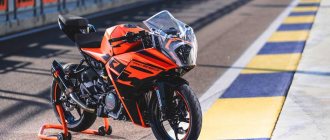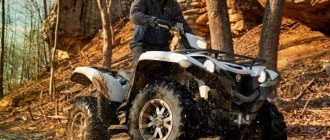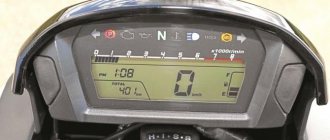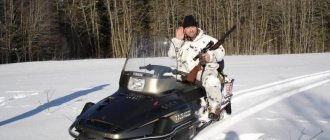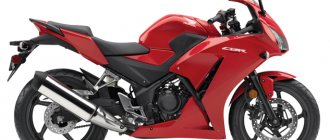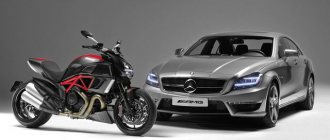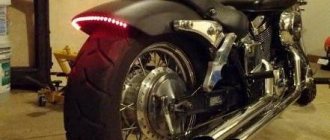Engine:
| engine's type | Single cylinder |
| Number of cylinders | 1 |
| Tact | 4 stroke |
| Cooling type | Liquid |
| Number of valves | 4 |
| Number of valves per cylinder | 4 |
| Engine Configuration | SOHC |
| Piston diameter (mm/in) | 102 / 4.02 |
| Piston stroke (mm/in) | 84 / 3.31 |
| Displacement (cc.cm/cu.in.) | 686 / 41.9 |
| Starter type | Electric |
| Fuel requirements | Standard |
| Fuel type | Petrol |
| Carburetor model | Keihin |
| Injector | + |
| Carburetor | – |
| Injection type | Fuel injection |
Yamaha Grizzly 700 EPS (2007 – present 350,000 – 1,050,000 RUR)
Yamaha Grizzly 700 EPS is one of the most respected and popular "junk" cars. Its phenomenal reliability is successfully complemented by a rather playful engine, which in total allows us to talk about the “Grizzly” as the best choice for those who want a utilitarian all-terrain vehicle with the ability to sweep across a field and the nearest copse, lifting clods of soil into the air.
Engine
The Yamaha Grizzly 700 EPS is equipped with a four-stroke, four-valve, 708 cc, single-cylinder, DOHC, liquid-cooled engine. In fact, this power unit traces its history back to the very moment the big “Grizzly” was born. Problems with it only occur in the case of complete drowning or severe rolling. The engine is extremely durable and you can’t blame it for a lack of power. There is a tendency to eat up oil with high mileage. The air intake and all breathers are located under the false tank at the seat level.
Transmission
The Yamaha Grizzly 700 EPS promotes the use of a classic CVT transmission in this type of technology. The beauty of the Ultramatic variator is its high strength. All other things being equal, the pulleys and related parts are quite large. It is extremely difficult to break a belt on a Grizzly 700. Switching between 2WD/4WD drive modes with the possibility of differential locking in 4WD is carried out using the On-Command system. The servo drive connects the front axle and lock quickly and efficiently. With all-wheel drive engaged and locked, the Yamaha Grizzly 700 has phenomenal cross-country ability.
Frame and body kit
The steel frame of the Yamaha Grizzly 700 EPS is laid in several tiers of a complex spatial structure. Parallel pipes and diagonals are carefully reinforced with perforated inserts. It is extremely difficult to destroy anything in this design. The body kit is made of viscous and dense plastic that does not break even at very low outside temperatures. The rough texture is covered with a large number of shallow scratches over time. Scratched areas absorb dirt, are difficult to wash and look sloppy. Camouflage paint may peel off in chunks where it is damaged.
Brakes
With simple single-piston calipers in a circle, the Grizzly 700 brakes impressively, as befits such a vehicle. You have to press the brake levers as hard as you can. For use off public roads, this behavior should be considered normal.
Pendants
The purely kinematically independent suspension of all wheels on A-shaped steel arms on the Grizzly 700 is designed more for high cross-country ability than for ultra-sensitive and controlled steering. Due to the large suspension travel, short wheelbase, high ground clearance and relatively small track, the Yamaha Grizzly 700 is noticeably tumbling. When you suddenly open the gas, the all-terrain vehicle easily rears up, and when turning, it rolls dangerously; at near maximum speeds, the course has to be adjusted. During the evolution, the manufacturer tried several times to minimize this behavior due to the length of the levers, but it did not achieve complete victory. Some of the rollovers can be avoided by using spacers to increase the track. The problem can also be minimized if you get used to working the throttle trigger smoothly. The suspension holds the jumps heroically. It is almost impossible to punch and break something during any hard landings. In theory, on 26-inch tires, the Grizzly can float on water without a driver.
Comfort
One of the features that significantly increases comfort is electric power steering, which has been installed on the Grizzly 700 from the very beginning of production. The power steering ensures easy and precise steering control in almost any conditions. The system is absolutely reliable. Indispensable in mud and difficult terrain.
Also, for the convenience of transporting cargo, the all-terrain vehicle is equipped with several trunks and luggage containers. Like other Japanese manufacturers, Yamaha does not encourage two-person riding of the ATV. Therefore, the Grizzly 700 is more of a one-and-a-half-seater than a two-seater. The passenger is given very little space.
Modifications
In 2014, forged pistons appeared in the power unit, and the filling was also significantly updated. In 2016, the engine switched to DOHC gas distribution and a liner cylinder, adding displacement and performance. In the same year, an additional headlight appeared on the steering wheel. In parallel with the basic version, a slightly more richly equipped (wheels, coloring, etc.) version SE is produced. Since 2016, based on the Yamaha Grizzly 700, a cheaper and simplified model of the Yamaha Kodiak 700 ATV has been produced.
Wheels and Tires:
| Disc material | Aluminum |
| Camera | Tube |
| Front wheel diameter | 21 |
| Rear wheel diameter | 22 |
| Chromed | – |
| Front wheel width | 7 |
| Front disc diameter | 10 |
| Rear wheel width | 9 |
| Rear disc diameter | 11 |
| Front tires | 21 X 7-10 |
| Rear tires | 22 X 9-11 |
Honda TRX 700 in Moscow
Year 2008 in PSM 2 owners. Registration/deregistration was done. The athletes did not own it. The owners are all adults and don’t know how to drive around the city on rear wheels and didn’t want to know how to drive). A very interesting option. Especially if you don’t get enough adrenaline from tourist-utilitarian quads. And you are already disappointed in them because... there are no emotions, and quad-drunks with friends 500 meters from the House, near the nearest puddle, do not bring the former delight))) High-speed shooting through forest clearings is guaranteed to not leave even the most experienced rider without emotions))) Rear independent suspension, makes it unique in its class and ideal for country use for enduro-tourism purposes. And the ground clearance of under 30cm will allow you to continue riding without any problems in the company of tourist quads, giving their owners, at every high-speed section, to drool seeing how quickly you move away in the clouds of road dust))) Perfect for people who want to ride right away without burdening yourself with repairs and maintenance. You don't need to do anything! I have fully serviced, tuned and lubricated. Big maintenance this winter, I changed everything that was necessary. (rear pads, throttle cable, wheel rims, filter everything, spark plug, etc.) the engine is made on the basis of the legendary Honda XR650 bike, therefore, in terms of reliability, the reserve is very large. I run a channel on YouTube about quads and snowmobiles (Herry Petrosso) on the channel you will find some information on its maintenance and in the near future I will post a full review on it there. Among the additional features: graphics, additional lights, steering spacer, hydraulic clutch drive (the factory clutch handle is very tight, hydraulics solved this problem. I’ll give away all the stock parts). Geographically located in the Lotoshinsky district of the Moscow Region. Put it up for sale due to the desire to make room in the garage for a new toy.
Let me draw your attention to the price, it is not negotiable. The price is indicated in the advertisement. Bargaining within reason. Thank you.
I have a trailer, if needed I can help with delivery. Ps The most frequently asked question is “what is the mileage?” I will answer here so as not to waste our common time. From the factory, this model is not equipped with an odometer or hour meter. Because athletes did not ride it, and the quad is not utilitarian or tourist, one can assume that the mileage was not great during the season. If we are to estimate the mileage very roughly and approximately, then my thoughts are as follows: my second ATV is also a Honda, and both have identical steering grips, so this one has 8t.km and there they are more worn out.
Suspension:
| Front suspension | Double wishbone |
| Front Suspension Travel (in/mm) | 10.6 / 269.2 |
| Pre-setting the suspension fork travel | + |
| Front Adjustable Rebound Damping | – |
| Front Central Suspension Strut | – |
| Front suspension model | Showa® |
| Steering Damper | – |
| F Stabilizer Bar | – |
| Rear suspension | Double wishbone |
| Rear suspension travel (in/mm) | 9.3 / 236.2 |
| Rear adjustable shock/spring preload | – |
| Rear Adjustable Rebound Damping | – |
| Rear shock absorbers | 2 |
| Rear Suspension Material | Aluminum/Steel |
| Anti-roll bar | + |
| Pneumatic adjustment | – |
Test drive HondaTRX700XX
After Polaris, which in 2007 created the world’s first sports ATV with independent rear suspension, the Outlaw 525 IRS, only Honda decided on such a bold experiment and rolled out its brutal beast TRX700XX to the market.
Naturally, you need to test a sports ATV on a cross-country track. He rolled out slowly, with an arrangement. And I liked everything at first. Landing, control, excellent grip in turns, even took aim at the jumps without much fear. However, with an increase in speed, black streaks of doubt began to spread across the bright positive “picture”.
The “quad” skidded easily, but it was impossible to go through the entire turn like a “fan”. At the exit, the device always strived to stand on two side wheels. When both rear wheels touched the ground at the same time after the jump, everything was great. But as soon as you “caught” the uneven takeoff, on landing one of the rear wheels touched the surface before the other, causing a sharp jerk to the side. The motor is generally “crazy”. According to independent dyno measurements, the TRX700XX peak power is 41.5 hp. With. To produce such power, you need to spin the engine to an unimaginable 6000 rpm. Sorry, but I personally couldn’t do this on the cross-country track.
So what happens? Handling in corners leaves much to be desired; the energy intensity of the suspensions for practicing jumps is clearly not enough. But the engine is from the “only for the fastest” class. The question is: who needs such an ATV and why, if due to the slurred operation of the suspension it is impossible to extract all its power potential from the engine. The answer seems obvious: reconfigure or even change the entire suspension to a tuned one and... train more. But after talking with the athletes and, with their permission, driving “charged” sports “quads” with a traditional continuous rear axle, the above answer no longer seemed so obvious. According to all comparative calculations with other “sports”, the TRX700XX has absolutely nothing to do on the cross-country track. So where should he go? Rally and enduro are the TRX700XX's habitat.
The steel frame, assembled from two parts, with a removable subframe, on which the elements of the independent rear suspension are fixed, forms a ground clearance of 267 mm that is gigantic for a sports ATV (for comparison: the Yamaha Raptor 700 sports ATV with a continuous rear axle has a ground clearance of 113 mm). On forest hummocks, on a dirt road with many ruts and potholes on the TRX700XX you can sprint at full throttle almost without getting up. Due to the location of the driving and driven stars clearly on the longitudinal axis of the ATV, the creators of the “quad” achieved not only equal angles for the rear CV joints, but also managed to increase the travel of the rear wheel suspensions to 23.6 cm. Which is quite comparable to the travel of the pendulum suspension on traditional “sports” " The fact that the TRX700XX is “tailored” for enduro and rally racing is indicated by both the electric starter and reverse gear as standard. Thoroughbred cross-country quads cannot afford such luxury. Curb weight of TRX700XX – 230 kg! Not a utilitarian car weighing 300 kg, of course, but it’s far from being a “sport” car, where weight values “walk” in the range of 170–190 kg. Probably overseas, where rally raids on sports ATVs are popular, the TRX700XX is an excellent choice for an athlete. Eh, if it still had front-wheel drive, then in Russia it would give a lot of heat in many trophy races on all-wheel drive ATVs. Well, this is an excellent device for an active weekend for those who do not like cross-country trails and who are tired of wasting mud on “utilities”. But not more.
Magazine "Cars"
Specifications:
| Length (ft) | 5.96 |
| Width (inch/mm) | 45.9 / 1165.9 |
| Height (inch/mm) | 44.7 / 1135.4 |
| Base Length (inch/mm) | 49.6 / 1259.8 |
| Ground clearance (inch/mm) | 10.5 / 266.7 |
| Length (foot/foot) | 5 |
| Length (foot/inches) | 11.5 |
| Dry weight (lb/kg) | 505 / 229.1 |
| Fuel tank capacity (gallon/L) | 3 / 11.4 |
| Performance | Standard |
Honda CTX700A – TEST
2014 onwards, 670 cm3, 48 l. s., 244 kg, 440,000 rub.
text: Alexander Barkalov photo: Nikita Kolobanov
in the photo: Alexander Barkalov
“Over the past few years, Honda has been boldly experimenting with crossing motorcycles from different segments, creating new, never-before-seen subclasses of equipment. The CTX family became one of the latest “acts” of genetic engineering of the Japanese concern, which tried to combine the advantages of three seemingly most distant types of motorcycles: naked, cruisers and tourers.
Common roots As has happened more than once in Honda's history, the debut in 2012 of the new NC700 family of road motorcycles led to a small but significant revolution in the industry. Initially, the Japanese released simple and unpretentious naked bikes and crossovers onto city streets, characterized by outstanding efficiency and ease of control. It turned out that the universal base of the NC700 suits so many different devices surprisingly well, so Honda decided to further expand the model range by adding touring motorcycles. In the winter of 2013, at the international motor show in Chicago, two new models built on a popular base were presented: the touring CTX700 and its naked version, the CTX700N. CTX (Comfort Technology Experience) devices were conceived as full-fledged universal motorcycles for every day and for long trips, made in the format of cruisers. The main design idea was the Horizontal Line Styling concept, with a characteristic low and elongated silhouette - this concept was also implemented in the Gold Wing F6B Bagger. It is certainly impossible to say that the design of the Honda CTX700 will appeal to everyone. In addition, we can say with a high degree of confidence that adherents of “real iron” motorcycles will generally be skeptical about the curved lines of a “plastic” cruiser. On the other hand, the CTX700 is positioned as an entry-level model aimed at young motorcyclists and the fair sex. And this audience has always been distinguished by multipolar views in matters of perception of design and aesthetics.
And if the question of the motorcycle’s extraordinary appearance remains open and may well become a reason for heated discussions, then the ergonomics of the driver’s seat in most cases causes an unambiguous reaction. When you sit behind the wheel of the CTX700, you find yourself not just on the seat, but as if “immersed” inside the motorcycle, becoming part of it. Such unusual sensations are due to the original posture formed by the low seat, wide and high handlebars and the footpegs placed far forward. Out of habit, you instinctively try to find a place to rest your feet in a familiar place, but over time you stop paying attention to this ergonomic feature. Otherwise, the pilot's position behind the wheel of the CTX700 can be called quite comfortable - especially for people of small and medium height. The “cruiser” dashboard is similar to those installed on the NC700S, the NC700X crossover and the Integra 700 maxi-scooter. Although the information content is quite high, the panel cannot boast of good readability of the readings - mainly due to the tape tachometer, made in the format of a running “snake”. Despite the same “base” with the naked NC700S, which implies the unification of components and assemblies, the CTX700 still has one significant difference, which is the fuel tank, located in a place familiar to most motorcyclists. Where the NC has a luggage capacity for storing a full-fledged integral helmet, the CTX has a hinged lid that hides a filler neck and a small compartment that can accommodate documents, a mobile phone and a bunch of keys.
cut-off is equipped with a 2-cylinder in-line engine with a displacement of 670 cm3, which has already proven itself well on devices of the NC family and the Integra scooter. Japanese designers decided not to tempt fate in trying to improve what was good, leaving the power unit without the slightest changes. The logic of the specialists at Honda headquarters is quite clear, because the smooth characteristics of the parallel “twin” are equally well suited for both a city motorcycle and a device for country trips and long trips. Modest by modern standards 48 liters. With. available at around 6250 rpm, and the engine produces peak torque values after 4500 rpm. Much more interesting than the maximum power indicators is the graph of its distribution: the horsepower output of the Japanese “two” occurs almost linearly and predictably. In turn, the torque graph also resembles a straight line, as if drawn with a ruler. Already from idle, the engine demonstrates confident traction, which does not weaken until the limiter is activated (at approximately 6325 rpm). As on the NC700S, the moment of activation of the limiter is not easy to track, and the “cutoff” itself is quite rigid. And everything would be fine, but you have to constantly turn the almost 700 cc engine, which is why encounters with the electronic “noose” occur more often than desired.
When talking about the CTX700 engine, Honda isn't afraid to use phrases like "outstanding fuel efficiency," which turns out to be true and not just another marketing gimmick. In city use, the engine demonstrates record low gasoline consumption - about 3.5 liters of AI-95 per 100 km! With such meager fuel consumption, the autonomy of the motorcycle rises to the level of serious touring machines, and this is about 350 km on one gas station. At the same time, on country trips in the “forgot to turn off the iron” driving mode, the 2-cylinder engine demonstrates a slightly larger, but still impressively modest appetite. On a fully filled tank with a volume of 12.4 liters at a speed of 140–150 km/h, you can easily travel 250 km, after which the indicator begins to flash, notifying you of the need to visit the gas station. Of course, in an effort to achieve outstanding efficiency results, Honda specialists had to make certain concessions, sacrificing maximum power and the breadth of the operating range of the power plant. However, there is no need to complain about the total weakness of the device. In the city, the CTX700 feels quite confident and is able to move quite dynamically in space. On country roads there are also no problems with overtaking or rapid acceleration. The CTX can only boast a maximum speed: it takes quite a long time for the motorcycle to accelerate to 170 km/h, and if there is a passenger, even this modest value becomes inaccessible to it.
The standard budget price tag of the Honda CTX700 suggests that most of its components do not spoil the owner of the motorcycle with outstanding characteristics and advanced technologies, but at the same time copes well with their functions. Thus, the positioning of the device is immediately revealed by a single brake disc on the front wheel and a thin fork, devoid of adjustments. By and large, despite its simplicity, serious claims cannot be made against the motorcycle braking system. The 320 mm disc and Nissin 2-piston caliper, supported by a 240 mm rear disc with a 1-piston caliper, are capable of predictably stopping not the lightest motorcycle from any speed. As a safety net, the Honda unit is equipped with combined ABS. The brakes and suspension of the motorcycle match: a non-adjustable fork with “bicycle” stays with a diameter of 41 mm, plus a pendulum rear suspension with a simple monoshock absorber. At the same time, the chassis potential is sufficient for everyday movement around the city and comfortable “long-distance driving” on roads of varying quality. It is also worth noting that the CTX700 has good handling. The main merit of the device's agility, it seems to me, is the low center of gravity: the engine is placed quite low in the steel tubular frame, and the cylinder block is inclined at a large angle forward. In turn, all the most significant parts in the literal sense of the word are assembled as close as possible to the center of mass of the device, which gives a balanced load on both wheels. The motorcycle is able to easily and quickly move from one turn to another and is endowed with enviable maneuverability, making it easier to move around the city even during the busiest rush hour. But there’s no need to revel in high-speed cornering on the CTX700: even at the most “civil” angles, the vehicle’s footrests begin to cling to the asphalt surface too early. But the owner always has the opportunity to take a turn, effectively sparkling the running boards under the admiring glances of passers-by.
Trending? Like the NC700S model, which essentially gave birth to a whole line of new motorcycles from Honda, the CTX700 turned out to be quite an interesting device. An intricate cross between a city bike, a cruiser and a tourer all rolled into one, the CTX has distinct features, be it its distinctive stance, bold design, frame construction or fuel-efficient engine. The Honda CTX700 is a motorcycle that attracts the buyer first of all with its unusual appearance, and only then captivates with its ease of operation, good performance and low cost. By adhering to the chosen strategy, the Honda concern in the very near future can make its simple mid-sized models extremely popular, thereby winning a huge new audience from among neophytes and people who, by and large, are far from motorcycling. And stylish cars like the Honda CTX700A may well be on the list of essential products for today's young people - along with an iPhone, a DSLR camera or a Diet Coke. /
Exterior:
| Frame material | Steel |
| Housing material | Plastic |
| ATV handlebar grips | Standard |
| Foot Peg Location | Driver |
| Seat adjusting system | – |
| Hand Guards | – |
| Power bumper | – |
| LightGuard | – |
| Front Fender | Standard |
| Rear Fender | Standard |
| Hand grips | Standard |
| Front bumper | Standard |
| Rear Bumper | Standard |
| Underbody protection | + |
